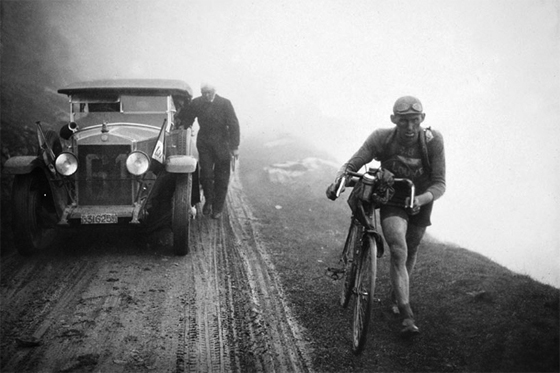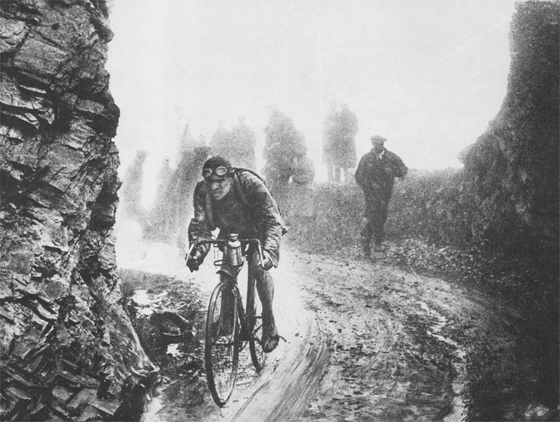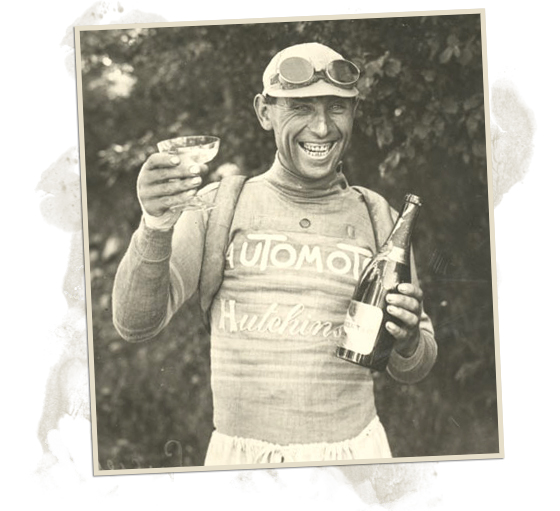Note: This post appeared on xxcmag.com in the winter of 2013. I really dig the post and since I’m not sure how much longer xxcmag.com will be live, I am preserving it here, so as not to let the post go to waste.
All too often modern-day riders and racers get caught up in Facebook, Twitter, message board and Strava pissing contests about their training, riding and racing and lose sight of the feats that our brothers and sisters have done before us.
Don’t get me wrong, I am not discounting the amazing adventures, rides and races that folks are doing on their bikes these days; i.e.Tour Divide, Iditarod Trail Invitational, Arrowhead 135, Trans Iowa, etc., etc., (all those races that I lack the talent, skills and man-giblets to ever attempt) I just think that on occasion we need to put some things into perspective and call attention to some past events, races and the vintage bad ass riders of yesteryear.
In the case of today’s post we are actually highlighting one of the hardest stages ever, in what is known as the hardest version, of what is arguably the most popular bike race in the world– The Tour de France. Stage 10 of the 1926 Tour de France to be exact.

Tour de France Stage 10: Bayonne – Luchon, 326 km
Tuesday, July 6th, 1926
At 5,745 km The 17 stage, 1926 Tour de France was the longest in history and its Stage 10 had just about everything you could imagine in a bike race and has long been noted as the toughest stage in Tour de France history. Here are some brief highlights of this epic stage in one of the most epic editions of the Tour in history.
Length: Yeah, you read right, 326km (202.5 miles). To put that in perspective in 2013 the longest stage on tap for the Tour is 242 km (150 miles), professional racers will be on 15 pound bikes with 11 speed drivetrains, racing on fully paved roads, with team cars, radios, bike swaps, etc., In 1926 racers would have been atop 30+ pound singlespeed bikes and pretty much on their own for repairs, etc.,
Of the 126 riders who started the 1926, 82 were non-sponsored independents. Only 41 racers would finish the ’26 Tour. By the way, while the 326 km is damn long, it was not actually the longest stage in 1926, that honor belonged to the flat, 433 km Stage 3: Metz to Dunkirk.
Climbs: Racers would ascend over 19,500 feet as they climbed a route called the “circle of death” which contained the Col d’Ousqich, Col d’Aubisque, Cirque du Litor, Col du Soulor, Col du Tourmalet, Col d’Aspin and Col de Peyresourde. Keep in mind at this time most– if not all– of the mountain roads were dirt and the foul weather turned many of them to wheel sucking mud as the stage wore on.

Weather: Because the distance and the climbing wasn’t enough of a hell for the racers to deal with, Stage 10 also contained heavy rain, thunder, lightning, sleet, wind, below freezing temperatures and icy mountain fog. Sick.
Start Time: Unlike the Tour of today with start times in the late morning to afternoon, Stage 10 of the 1926 Tour would have riders starting at 2 a.m. in the morning. Not sure what sort of crowd they had for the send off or how many silly sponsor vehicles lead the riders over the passes. It also unknown (but highly doubted) if the racers utilized high powered L.E.D. lights to guide themselves through the dark hours of the race as we happily do today.
A Race: For most, it would be enough just to survive or finish such as stage, but the fact is, this was the Tour de-freaking France… not just a race, THE race! And race they did. Gustaaf Van Slembrouck started the day in the yellow jersey, 22 minutes down on him was the Belgian Lucien Buysse and on this day Buysse was not to be denied. Not only did he battle the elements and the climbs but he also found the energy and the will to put in multiple attacks on a small lead group of rivals in the mountains. Finally he opened up a gap on the Col de Peyresourde that stuck and crossed the line in Luchon, taking the Stage 10 victory in a time of 15 Hours, 12 minutes and 4 seconds and the yellow jersey. Odile Taillieu would finish 36 minutes 14 seconds behind him.
For a much more detailed account of Stage 10′s racing, the life of Lucien Buysse and the 1926 Tour check out the site velopeloton.com (the website is rich with historic tales of old racers and was invaluable in creating this post).
 Can we rest now? Yeah, luckily the racers got the next day off to recover and ready for the shorter Stage 11… By “shorter” I mean it was only 323 km instead of 326, with just five cols to climbs. By the way Lucien Buysse would win Stage 11 as well, the result of a 150 km solo breakaway. The Stage 11 victory sealed the overall victory for Buysse and after 238 hours and 44 minutes he arrived in Paris on July 18th, 1926 the winner of the 20th edition of the Tour de France.
Can we rest now? Yeah, luckily the racers got the next day off to recover and ready for the shorter Stage 11… By “shorter” I mean it was only 323 km instead of 326, with just five cols to climbs. By the way Lucien Buysse would win Stage 11 as well, the result of a 150 km solo breakaway. The Stage 11 victory sealed the overall victory for Buysse and after 238 hours and 44 minutes he arrived in Paris on July 18th, 1926 the winner of the 20th edition of the Tour de France.
